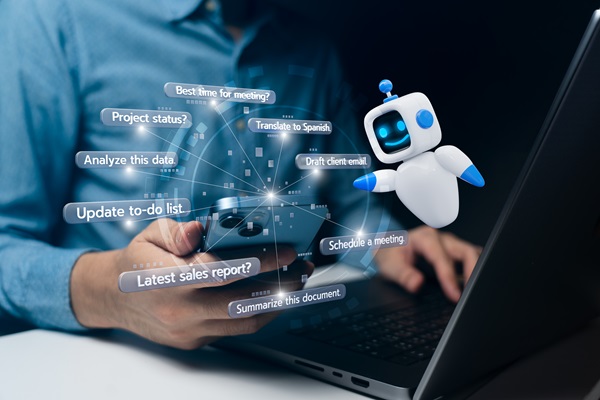.png)

Kembai Srinivasa Rao is a former banker who teaches and usually writes on Macroeconomy, Monetary policy developments, Risk Management, Corporate Governance, and the BFSI sector.
July 2, 2025 at 1:37 PM IST
Artificial intelligence is no longer an abstract idea. It is an active colleague. Virtual assistants are already replacing humans in routine roles. Soon, they’ll be sharing desks with us.
As organisations begin to lean on voice-based AI tools for communication, scheduling, customer service, and data handling, the shift is unmistakable. A key characteristic of AI tools is their lack of emotions; they do not possess empathy, pity, or an understanding of human hardships. Unlike humans, AI tools can work around the clock, limited only by their design and the capabilities of the algorithms that power them.
The future of work is not man versus machine, but man with machine. Whether this coexistence becomes collaborative or competitive depends on how we prepare for it.
Intelligence, Evolving
AI’s rise has been both steady and steep. We began with low-intelligence, reactive, rule-based bots, such as early chatbots that use fixed dialogue scripts. Common examples include virtual voice assistants such as Amazon’s Alexa, Apple’s Siri, and Google Assistant.
Then came medium-intelligence tools, which recognised patterns and handled repetitive tasks through robotic process automation, such as self-driving cars and advanced chatbots.
We now find ourselves in the realm of generative and agentic AI: systems that can write, code, analyse, mimic voices, and produce images. Large language models, such as ChatGPT, are no longer just assistants; they are co-creators.
But that’s not the final stop. On the horizon are AI systems with emerging advanced intelligence: machines that can reason, learn across context, and transfer knowledge autonomously. And beyond that lies superintelligence: a hypothetical stage where machines surpass human cognition altogether. While currently in the realm of science fiction, the concept of Artificial Superintelligence continues to be actively explored by researchers.
Quantum Leap
Fuel is being added to this transformation by quantum computing, a fundamentally different way of processing information. Instead of binary bits that represent 0 or 1, quantum computers utilise qubits, which can exist in multiple states simultaneously due to phenomena like superposition and entanglement. This enables them to solve complex problems at speeds that would overwhelm even the fastest supercomputers.
When merged with AI, quantum computing could revolutionise model training, natural language processing, and image recognition.
Quantum machine learning leverages quantum superposition and entanglement to efficiently explore large solution spaces, speeding up tasks like clustering, classification, and optimization that are vital for generative AI, pattern recognition, and simulation workloads. Quantum optimization can also enhance hyperparameter tuning in generative models, resulting in faster and more innovative outputs, which further strengthens the connection between AI and quantum computing.
Quantum machine learning holds promise across sectors—from faster drug discovery and precision healthcare to optimised logistics, financial forecasting, and real-time cybersecurity.
In cybersecurity, the combined capabilities of AI and quantum computing can lead to more secure encryption methods and quicker threat detection. Similarly, financial institutions are exploring quantum-AI solutions for portfolio optimisation and risk assessment.
Jobs, Rewritten
The fear that AI will take away jobs is not misplaced. Routine and repetitive roles are the first to go. But panic will not help; preparation will.
Virtual Assistants might displace some roles, but they will also create new ones. The challenge is that these new jobs require entirely different skill sets. Knowing how to work with AI may become more important than learning how to code it.
For this to happen, education must adapt. Digital fluency should start at the school level. Higher education must encourage critical thinking and interdisciplinary skills. It’s not enough to be a user of technology; we must become interpreters, regulators, and designers of it. The new generation must not rely solely on what technology can do, but harness it.
India’s young population is a demographic advantage, but only if it’s equipped for the world that’s coming, not the one that’s fading.
From IT to EQ
Over the past few decades, India has emerged as the world’s back office, producing an army of IT professionals. But that era is changing. AI can now perform much of what entry-level coders, analysts, and customer service agents were previously hired to do.
The next wave of relevance lies in what machines can’t do well: empathy, ethics, intuition, and contextual decision-making. These aren’t just soft skills. They are survival skills. Wider industry skills.
Businesses will need to rethink how they hire, train, and retain talent. Policymakers must ensure that digital transformation doesn’t widen inequality. And citizens must invest in lifelong learning.
Technology is not the enemy. Like any significant change, it disrupts and then rebuilds. The question is whether we are ready to rebuild ourselves fast enough.
Virtual assistants are not just tools. They are becoming part of the organisational structure. Working with them effectively will demand a new kind of professionalism, blending tech literacy with human-centric judgement.
The way forward is not to resist the rise of virtual colleagues, but to ensure that they work for us, not the other way around.




